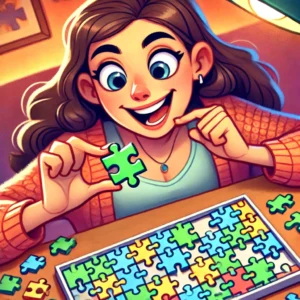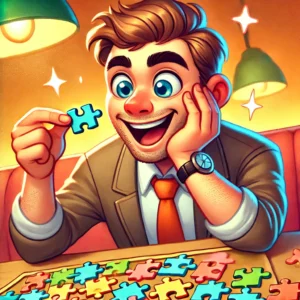
Speed Puzzling isn’t just about luck. It’s about a jigsaw Pattern Recognition System that players use to go faster and solve quicker. Anyone can use this technique and succeed. The thing is, most puzzle players don’t talk about it as it’s their secret speed puzzle technique of choice.
Jigsaw Puzzle Pieces Aren’t all the Same
Jigsaw puzzles are a fun and rewarding challenge, but have you ever wondered how some people seem to fly through them at lightning speed? Welcome to the world of speed puzzling – where puzzle enthusiasts work to solve puzzles faster by using smart techniques and efficient strategies. Speed puzzling is intense, especially during a puzzle competition.
Table of Contents
One of the most powerful tools for speed puzzling is pattern recognition. Instead of randomly searching for pieces, top puzzlers train their eyes to spot shapes, colors, and textures in a way that dramatically speeds up the solving process. If you want to puzzle faster and more efficiently, learning a pattern recognition system is the key!
Let’s break down how this works and how you can start using it today.
What is Piece Pattern Recognition in Speed Puzzling?
Pattern recognition is the ability to quickly identify visual cues—such as edge shapes, color clusters, and texture variations—to place pieces correctly without hesitation. Instead of picking up a piece and scanning the entire puzzle for a match, your brain learns to quickly categorize pieces based on their most distinctive features.
This skill comes naturally with practice, but by using a structured system, you can develop it much faster!
How to Use Pattern Recognition to Solve Jigsaw Puzzles Faster
Here’s a simple step-by-step method to start improving your pattern recognition and increasing your puzzle speed.
Step 1: Sort Pieces by Type First, Not by Color
Most beginners focus only on colors, but the shape of the piece is just as important. Start sorting based on these categories:
- Edge pieces. These create your frame, making it easier to place interior pieces.
- Tabs and blanks. Pieces have either “tabs” (the sticking-out parts) or “blanks” (the indentations). Sorting them helps you quickly find matching connections.
- Distinctive patterns. Look for unique textures, letters, or high-contrast color sections.
Step 2: Identify the Most Common Piece Shapes
Jigsaw puzzles typically have a set number of piece shapes. This sounds crazy, but take a peek at a jigsaw puzzle and you will immediately notice this is standard. Train your brain to recognize these at a glance:
Two tabs, two blanks – Standard middle pieces.
Three tabs, one blank – Often near the edges.
One tab, three blanks – Usually a border or near a detailed section.
Four tabs (or four blanks) – Rarer but can stand out.
By memorizing these basic shapes, you’ll immediately know where a piece might belong without scanning the entire puzzle aimlessly.
Step 3: Use “Fast Scanning” for Color Clusters

Instead of searching for one piece at a time, train your eyes to see the puzzle as a whole. Here’s how:
Glance at the entire puzzle image and identify major color clusters.
Find the most vivid colors or strong patterns first—sky blues, bright reds, or high-contrast edges.
Grab multiple pieces that match that section and sort them before you start placing them.
This method prevents you from constantly scanning the whole table, which slows you down.
Step 4: Work from the Inside Out (Not Just the Edges!)
Many puzzlers start with the border, but speed puzzlers know that solving recognizable sections first is often faster.
Try these quick wins first:
Faces, text, or logos – Anything highly detailed should be solved before you finish the edges.
Sky or background areas – Look for gradient shifts (light to dark) to speed up sky pieces.
Repeating patterns – If a puzzle has repeating tiles, textures, or stripes, group them early to solve faster.
Step 5: Train Your Brain with Speed Rounds
Want to improve quickly? Practice pattern recognition in small bursts!
Try this speed training exercise:
Grab 10 random pieces and set a timer for 30 seconds.
Sort them by shape and pattern without looking at the box image.
Try placing them as fast as possible.
Repeat this exercise, and soon, your brain will automatically recognize piece shapes and patterns without much effort!
Bonus: Pro-Level Speed Puzzling Tips
Want to push your puzzle-solving speed even further? Try these expert tips:
- Work in sections – Completing small, recognizable sections first allows you to quickly snap them into the bigger picture.
- Stand up while puzzling – A higher viewpoint helps you spot patterns faster.
- Use a puzzle mat – This lets you rotate sections easily and move pieces closer without disrupting your layout.
- Flip pieces faster – Keep all pieces facing up immediately after sorting to reduce wasted time.
Why Speed Puzzling is So Rewarding
Speed puzzling isn’t just about solving quickly – it’s about efficiency, focus, and mastery. The more you train your eyes to recognize shapes, patterns, and colors instantly, the faster you’ll complete puzzles. And the best part? You’ll have way more fun because you’ll avoid frustration and feel a real sense of accomplishment!
Whether you’re aiming to beat a personal record, compete in a puzzle tournament, or just finish your puzzles faster, using a pattern recognition system will give you a serious edge. So grab a puzzle, put these strategies into action, and watch your solving speed soar!
